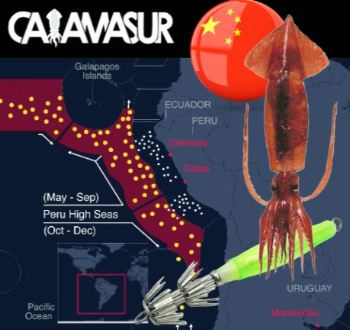|

Image: Sea Shepherd / FIS
Three years of progress and challenges in the fight against illegal fishing in the South Pacific
 PERU
PERU
Thursday, September 07, 2023, 01:00 (GMT + 9)
The fight against illegal, unreported and unregulated (IUU) fishing, in the vast horizon of the Pacific Ocean, is a constant battle. This month marks the three-year anniversary of the implementation of Supreme Decree No. 016-2020-PRODUCE in Peru, a regulation designed to curb illegal fishing activities in our marine domain and guarantee the sustainability of the resources it harbors.

Source: Círculo de Políticas Ambientales / Wiki / FIS
This rule provides that only those vessels that have the Satellite Tracking System (SISESAT) of the Ministry of Production installed and operational to access port services and national shipyards can enter the Peruvian sea. Its main objective is clear: to eliminate IUU fishing practices that have been occurring for several years now in our 200-mile limit. Since its entry into force, the standard has shed light in the midst of a sea of challenges.
Since the entry into force of the Supreme Decree to date, we have witnessed significant progress. The implementation of SISESAT has had a tangible impact in reducing the number of foreign industrial vessels that used to frequent our ports, many of them involved in illegal fishing activities. According to Alfonso Miranda, president of CALAMASUR (Committee for the Sustainable Management of the Giant Squid of the South Pacific), the supreme decree has marked a before and after in the fight against illegal fishing in Peru.
 “Before this regulation, we provided logistical facilities for the use of our ports to a fleet that had been caught on various occasions turning off their satellite equipment to enter Peruvian and Ecuadorian waters to fish illegally. Today, those vessels that decided not to implement the satellite tracking system cannot enter to use our port services”, he comments. “Before this regulation, we provided logistical facilities for the use of our ports to a fleet that had been caught on various occasions turning off their satellite equipment to enter Peruvian and Ecuadorian waters to fish illegally. Today, those vessels that decided not to implement the satellite tracking system cannot enter to use our port services”, he comments.
Although only five vessels have installed this system, the decline in the use of Peruvian port services by questionable fleets is undeniable. This is direct testimony that the rule is putting pressure on IUU fishing practices and beginning to reverse the damage inflicted on our seas. However, not everything is rosy.
As in any constant struggle, challenges persist. Despite initial successes, some vessels have found ways around the rule. The modality of “forced arrivals”, that is, emergency situations that require port assistance due to technical or health problems of the crew, has been used as a means to evade controls and carry out illegal fishing activities. Although these situations are legitimate in some cases, compared to previous years, there has been an increase in their use with less clear motivations, raising questions about their authenticity. Throughout 2021, Peru registered 12 forced arrivals, during 2022 there were 29; and between January and August 2023, the number rose dramatically to 75.

Source: Oceana Perú / Sea Shepherd
It is crucial that we remain vigilant and prevent these strategies from eroding the efforts made thus far. Oceana Peru and all the organizations committed to this cause maintain a firm position: we must maintain and strengthen the implementation of Supreme Decree No. 016-2020-PRODUCE. SISESAT and the transparency it brings to fishing activities are the key to a sustainable future. We cannot allow the pressure to make the regulation more flexible to prevail over the need to conserve our marine resources, as emphasized by experts and leaders in the fishing sector.
The third anniversary of this regulation is not only a milestone in the fight against illegal, unreported and unregulated fishing, it is also a call to action. The battle is far from over, but with continued commitment, the standard will continue to be a beacon of hope for our sea.
Source: Oceana Perú (Traslated from the original in Spanish)

Related News:



[email protected]
www.seafood.media
|



